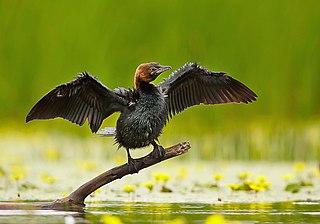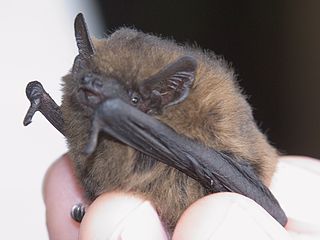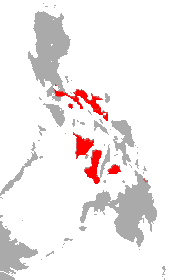
The Acrobatidae are a small family of gliding marsupials containing two genera, each with a single species, the feathertail glider from Australia and feather-tailed possum from New Guinea.

The feathertail glider, also known as the pygmy gliding possum, pygmy glider, pygmy phalanger, flying phalanger and flying mouse, is a species of marsupial native to eastern Australia. It is the world's smallest gliding mammal and is named for its long feather-shaped tail.

The pygmy cormorant is a member of the Phalacrocoracidae (cormorant) family of seabirds. It breeds in south-eastern Europe and south-western Asia. It is partially migratory, with northern populations wintering further south, mostly within its breeding range. It is a rare migrant to western Europe.

The royal antelope is a West African antelope, recognised as the world's smallest antelope. It was first described by Swedish zoologist Carl Linnaeus in 1758. It stands up to merely 25 centimetres (10 in) at the shoulder and weighs 2.5–3 kilograms (5.5–6.6 lb). A characteristic feature is the long and slender legs, with the hindlegs twice as long as the forelegs. Horns are possessed only by males; the short, smooth, spiky horns measure 2.5–3 centimetres (1.0–1.2 in) and bend backward. The soft coat is reddish to golden brown, in sharp contrast with the white ventral parts. In comparison to Bates's pygmy antelope, the royal antelope has a longer muzzle, broader lips, a smaller mouth and smaller cheek muscles.

The common pipistrelle is a small pipistrelle microbat whose very large range extends across most of Europe, North Africa, southwestern Asia, and may extend into Korea. It is one of the most common bat species in the British Isles. In Europe, the northernmost confirmed records are from southern Finland near 60°N.

The soprano pipistrelle is a small bat that in taxonomy was only formally separated from the common pipistrelle in 1999. It is possible that these two groups diverged from one another in the Mediterranean, and that is why Pipistrellus pygmaeus has the ability to thermoregulate at temperatures as high as 40 degrees Celsius.

The Bornean orangutan is a species of orangutan native to the island of Borneo. Together with the Sumatran orangutan and Tapanuli orangutan, it belongs to the only genus of great apes native to Asia. Like the other great apes, orangutans are highly intelligent, displaying tool use and distinct cultural patterns in the wild. Orangutans share approximately 97% of their DNA with humans.
Veigaiidae is a family of mites belonging to the superorder Parasitiformes. However they are not parasitic but free-living and predatory and are found in soil and decaying organic matter. Some species are specialists of rocky shorelines. Members of this family can be distinguished by a hyaline appendage on the tarsus of the pedipalp.
Gamasolaelaps bellingeri is a species of mite belonging to the family Veigaiidae. The female is only 0.5 mm in length, the male even smaller. Both can be recognized by the dorsal sclerotized shield being deeply incised laterally. This species is found in damp habitats such as moss and leaf litter in Jamaica.

The little ground squirrel or little souslik, is a species of rodent in the family Sciuridae. It is found from Eastern Europe to Central Asia.

The Philippine pygmy roundleaf bat, also called the Philippine pygmy leaf-nosed bat, is a species of bat in the family Hipposideridae. It is endemic to the Philippines, where it has been recorded on Bohol, Luzon, Marinduque, Negros, Panay, and Mindanao.

Scyllarus arctus is a species of slipper lobster which lives in the Mediterranean Sea and eastern Atlantic Ocean. It is uncommon in British and Irish waters, but a number of English-language vernacular names have been applied, including small European locust lobster, lesser slipper lobster and broad lobster.
The pygmy bamboo bat is a species of vesper bat in the family Vespertilionidae. It is found in Southwest China and was discovered in 2007. The species is around 4 cm long and weighs between 2.6 and 3.5 grams.
Gamasolaelaps arborescens is a species of mite in the family Veigaiidae.
Gamasolaelaps aurantiacus is a species of mite in the family Veigaiidae.
Gamasolaelaps excisus is a species of mite in the family Veigaiidae.
Gamasolaelaps multidentatus is a species of mite in the family Veigaiidae.
Gamasolaelaps tuberculatus is a species of mite in the family Veigaiidae.
Gamasolaelaps whartoni is a species of mite in the family Veigaiidae.
Scyllarus pygmaeus is a species of slipper lobster that lives in shallow water in the Mediterranean Sea and eastern Atlantic Ocean. It grows to a length of 55 mm (2.2 in), which is too small for it to be fished for. The juvenile form was first described in 1885, with the description of the adult following in 1888 as a result of the Challenger expedition.









